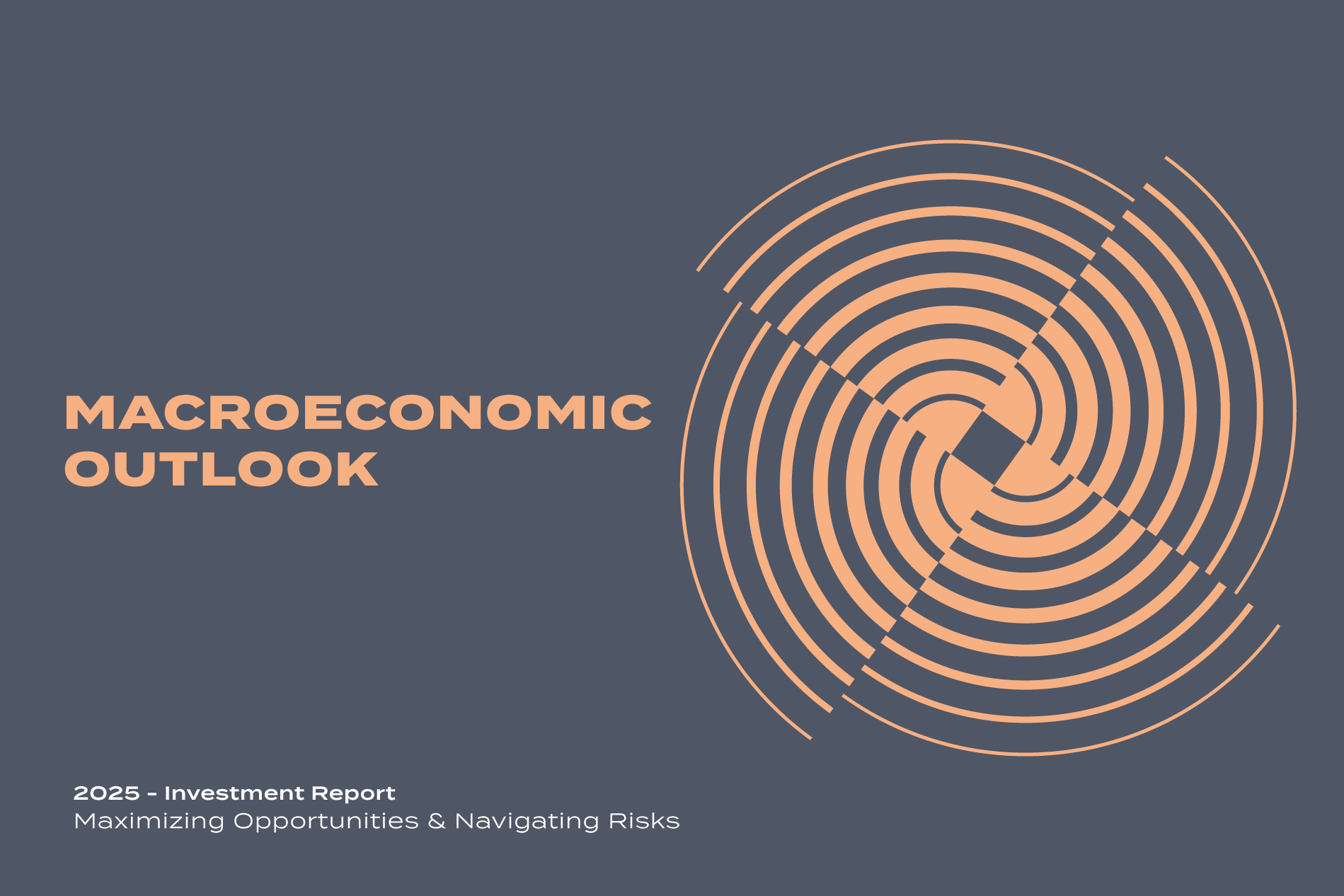
.png)
United States of America
The U.S. economy exhibited a stellar performance over the last two years. This is evident from the strong economic reports, upbeat corporate earnings, and the impressive performance of the stock market. Although the battle against inflation continues, considerable progress has been made in taming it over the last 18-month period. Headline inflation in the U.S. rose to 2.7% in November 2024, down from the eye-watering peak of 9.1% in June 2022. Meanwhile, Core CPI accelerated at 3.3% during the month. The Conference Board Economic Forecasts indicate inflation could potentially stabilise at the Fed’s 2% target in Q4’2025 instead of Q2’2025 projected earlier. The Federal Reserve slashed interest rates thrice in 2024, resulting in a cumulative 100 basis points of easing. As a result, the Fed Funds Target Rate fell from a peak of 5.25% and 5.50% to a range between 4.25% and 4.50%. Moving forward, the central bank has signalled just two more rate cuts in 2025, down from four rate cuts anticipated during the September FOMC meeting. The median dot plot anticipates a Fed Funds Target Rate of 3.9% by the end of 2025, 3.4% by the end of 2026, and 3.1% by 2027. Furthermore, the median dot for the longer-run neutral interest rates was revised upwards to 3.0%. The Fed’s cautious stance is warranted by the U.S. economy's persistent strength and anticipation of a potential revival in inflationary pressures under Trump’s administration. According to the U.S. Bureau of Economic Analysis, the final estimate of the third-quarter 2024 U.S. GDP was revised upwards to 3.1% from a previous estimate of 2.8%. It also marks a slight uptick from 3.0% in Q2’2024. Overall, Fed officials estimate real GDP growth of 2.5% in 2024. The economy is expected to continue expanding in 2025, albeit at a slower pace of 2.1% in 2025 and 2.0% in 2026.
.png)
Eurozone
The eurozone economy grappled with numerous issues in 2024, from political turmoil and subdued economic data to slowing growth and weakness in the manufacturing sector.
The extent of this impact hinges on the specifics of these policies, which should become more apparent once Trump takes office. A modest increase in tit-for-tat tariffs between the U.S. and China is expected in 2025, likely resulting in a relatively small net impact on GDP across most major EMs outside of China. However, significant downside risks remain, including the potential for tighter financial conditions due to trade-related uncertainties.
Aggregate growth in emerging economies is forecasted to slow to 3.8% in 2025 and 2026, down from 4.1% in 2024, with substantial regional and country-level variation. Rising trade protectionism and efforts by large economies to strengthen domestic industries have rendered external demand a less reliable catalyst for growth. Growth in EMs is expected to be supported by a rise in domestic and foreign demand as central banks ease monetary policies.
In Asia Pacific, economic growth is expected to remain the highest among EMs despite slowdowns in China and India. Meanwhile, Southeast Asia could benefit from shifts in global supply chains. An uptick in growth can be expected in the Middle East and Africa, particularly in Sub-Saharan Africa and Saudi Arabia. Resilient commodity demand alongside economic diversification initiatives is expected to propel these economies. Meanwhile, growth in Central and Eastern Europe and the Commonwealth of Independent States is forecasted to slow due to challenges in Russia and Turkey. Inflation is expected to ease in major EMs, with global central banks moving toward neutral monetary policies in 2025.
A struggling property sector and uncertainty around new fiscal and monetary measures impact China’s growth. In contrast, strong household consumption and a healthy private sector could support India's growth.
.png)
Emerging Markets
Trump’s trade protectionist policies may affect GDP growth in many emerging markets (EMs) over the next few years.
The extent of this impact hinges on the specifics of these policies, which should become more apparent once Trump takes office. A modest increase in tit-fortat tariffs between the U.S. and China is expected in 2025, likely resulting in a relatively small net impact on GDP across most major EMs outside of China. However, significant downside risks remain, including the potential for tighter financial conditions due to trade-related uncertainties.
Aggregate growth in emerging economies is forecasted to slow to 3.8% in 2025 and 2026, down from 4.1% in 2024, with substantial regional and country-level variation. Rising trade protectionism and efforts by large economies to strengthen domestic industries have rendered external demand a less reliable catalyst for growth. Growth in EMs is expected to be supported by a rise in domestic and foreign demand as central banks ease monetary policies.
In Asia Pacific, economic growth is expected to remain the highest among EMs despite slowdowns in China and India. Meanwhile, Southeast Asia could benefit from shifts in global supply chains. An uptick in growth can be expected in the Middle East and Africa, particularly in Sub-Saharan Africa and Saudi Arabia. Resilient commodity demand alongside economic diversification initiatives is expected to propel these economies. Meanwhile, growth in Central and Eastern Europe and the Commonwealth of Independent States is forecasted to slow due to challenges in Russia and Turkey. Inflation is expected to ease in major EMs, with global central banks moving toward neutral monetary policies in 2025.
China’s growth is impacted by a struggling property sector and uncertainty around new fiscal and monetary measures, while India’s growth could remain supported by strong household consumption and a healthy private sector.
.png)
2025 EARNINGS SNAPSHOT
U.S. - Solid Core Fundamentals
The global markets are entering 2025 with a relatively solid fundamental backdrop. The recent Q4 US earnings show an average y-o-y growth rate for the benchmark SPX500 index at 11.9%. This growth rate would be, in fact, one of the highest seen over the last 4 years. Markets now expect SPX 500 to report double-digit earnings growth for 2025. The expected earnings growth rate is 14.8%, higher than the trailing 10-year annual average of 8% (2014 – 2023 cycle). One of the major reasons for such an optimistic number is that analysts expect earnings growth to be broader based (beyond the Mag 7 components).
While Mag 7 growth is expected at 21%, the other 493 companies are expected to report growth from 12% to 14% range. On a most optimistic basis, based on the expected SPX 500 growth rate trend range of 12.5 % to 15%, the estimated 2025 year-end target for the index is now pegged at the 6,500 range. It is based on the average P/E of 24.30 (taken near the end of the last 5-year P/E range of 19 to 24.50).
Europe – Likely to be Pressured by Domestic Issues and Trump Tariff Threats
At a combined regional level, the eurozone GDP growth is pegged at 1.2 % for 2025, better than the 2023 & 2024 average GDP rate of 0.6%. Earnings-wise, the actual growth rate is now estimated in the 8% range for the following year. However, it should be noted that the region faces major threats, including political instability among its key members – France and Germany- the likely trade tariff rhetoric and any imposition of the actual tariffs. Even leaving aside the exogenous factors, the risk towards the Eurozone earnings outlook seems to be tilted towards the downside. Any rebound is likely to be slow and shallow as tariff threats and cyclical slag would negatively impact a few sectors. For the earnings outlook, one of the biggest tailwinds could be any sharp reduction in the interest rates by the ECB should any major labor market slack off or a slowdown in inflation materializes.
Japan is currently experiencing an inflationary environment, leaving behind its three-decade-old disinflationary spiral. While this can be healthy for further economic and wage growth, investors also need to watch out for heightened depreciation in the yen, which could adversely impact the economy’s growth dynamics.
Century Financial Consultancy LLC (CFC) is duly licensed and regulated by the Securities and Commodities Authority of UAE (SCA) under license numbers 2020000028 and 2020000081, to practice the activities of Trading broker in the international markets, Trading broker of the Over-The-Counter (OTC) derivatives and currencies in the spot market, Introduction, Financial Consultation and Financial Analysis, and Promotion. CFC is a Limited Liability Company incorporated under the laws of the UAE and registered with the Department of Economic Development of Dubai (registration number 768189).
CFC may provide research reports, analysis, opinions, forecasts, or information (collectively referred to as Information) through CFC’s Websites, or third-party websites, or in any of its newsletters, marketing materials, social media, individual and company e-mails, print and digital media, WhatsApp, SMS or other messaging services, letters, and presentations, individual conversations, lectures (including seminars/webinars) or in any other form of verbal or written communication (collectively referred to as Publications).
Any Information provided in this publication is provided only for marketing, educational and/or informational purposes. Under no circumstances is any Information meant to be construed as an offer, recommendation, advice, or solicitation to buy or sell trading positions, securities, or other financial products. CFC makes no representation or warranty as to the accuracy or completeness of any report or statistical data made in or in connection with this Publication and accepts no responsibility whatsoever for any loss or damage caused by any act or omission taken as a result of the use of the Information.
Please refer to the full risk disclosure mentioned on our website.



__1102779201.jpg)












